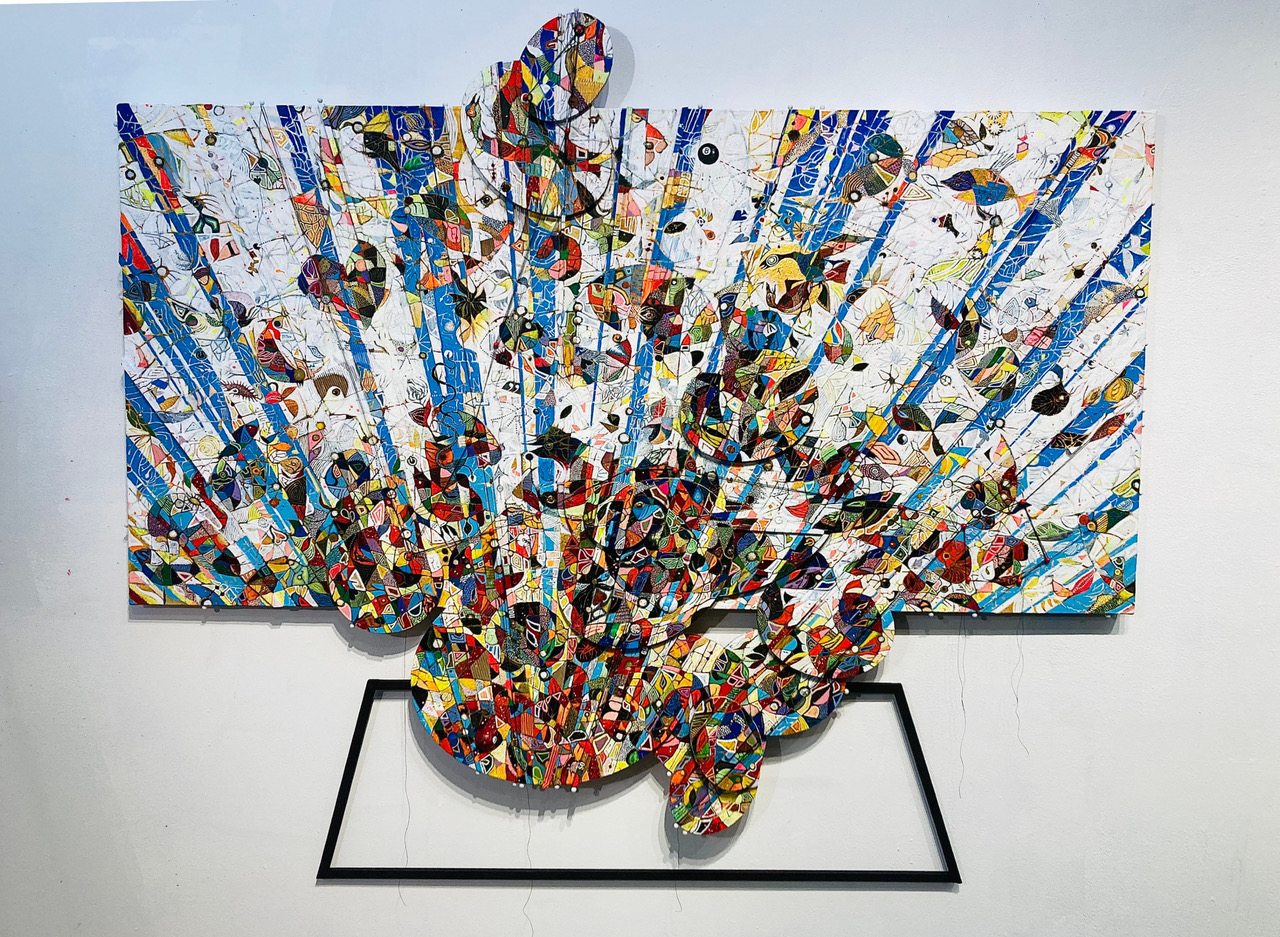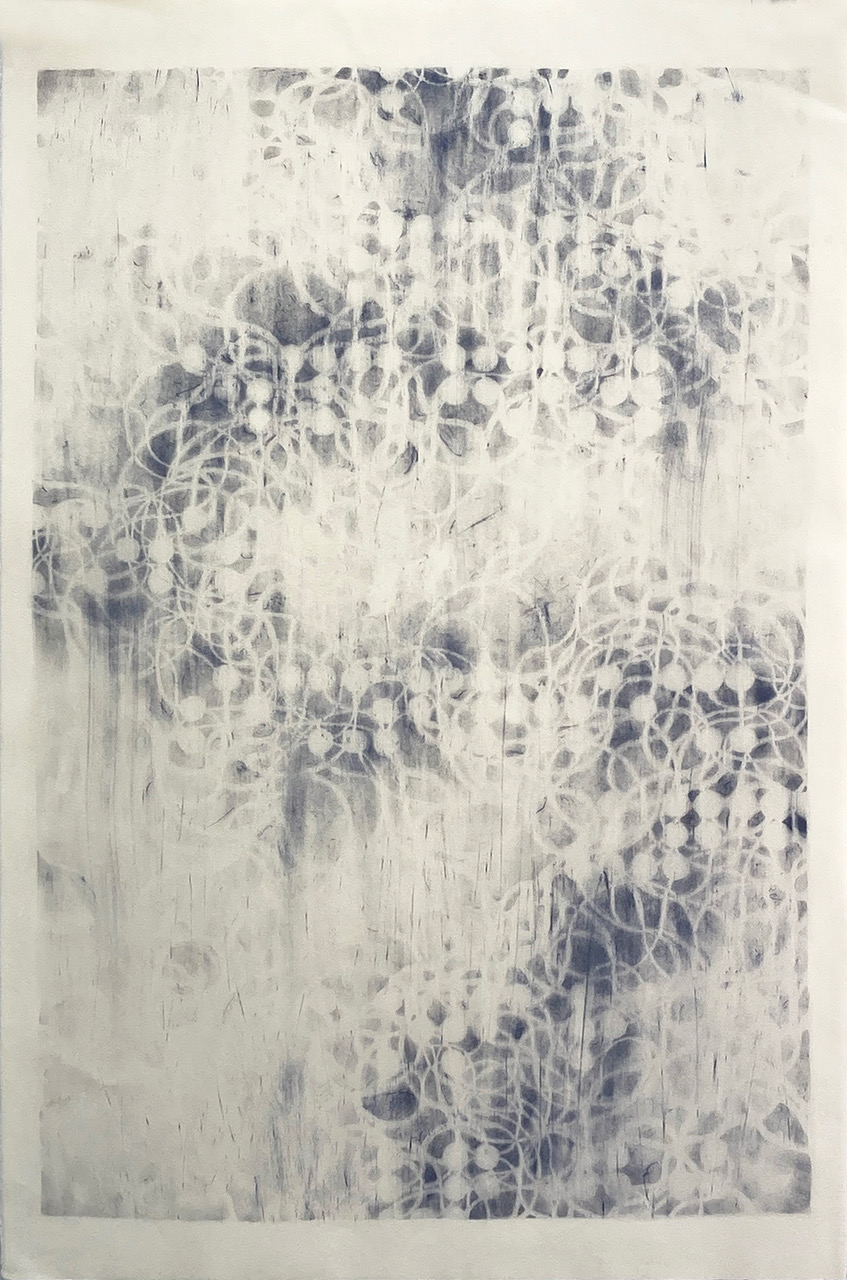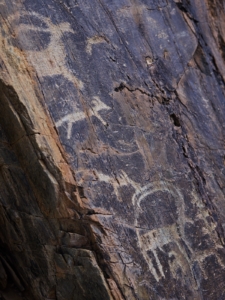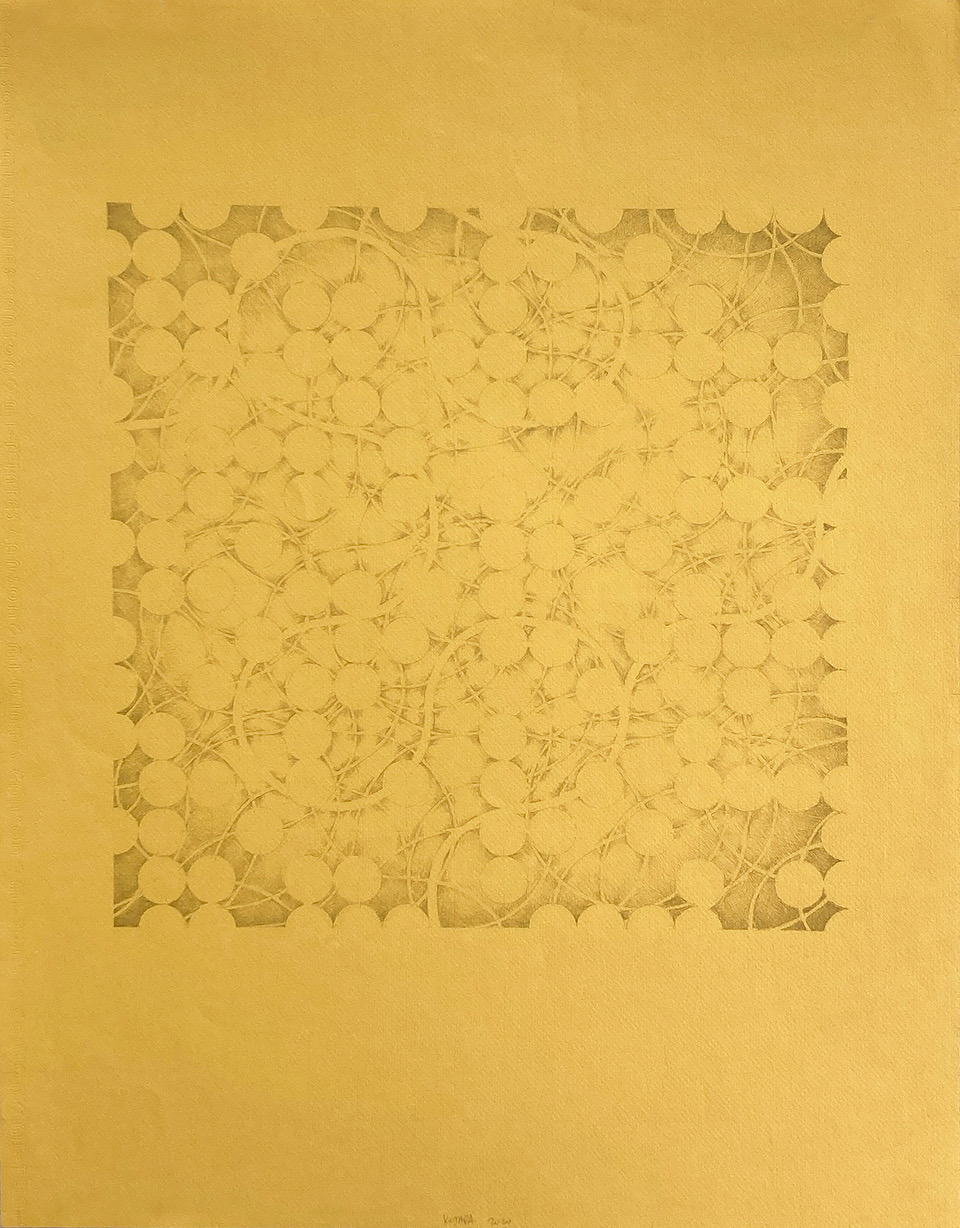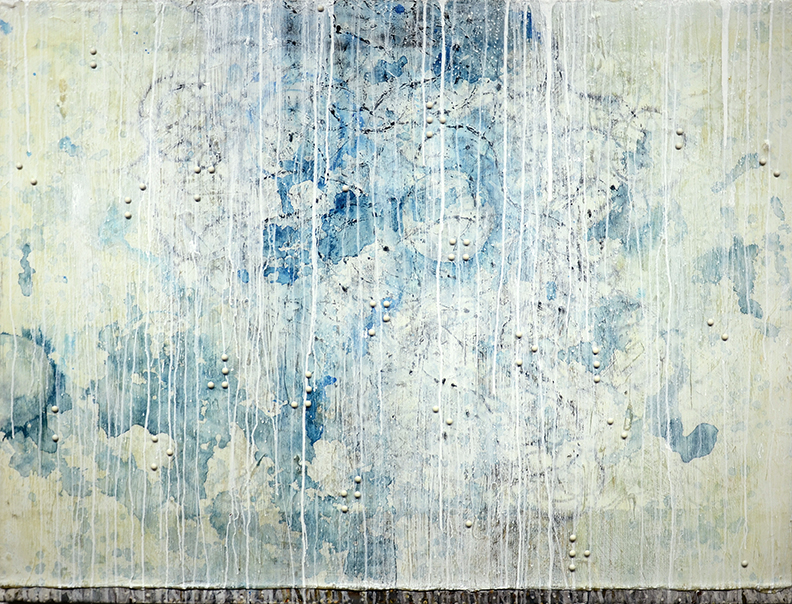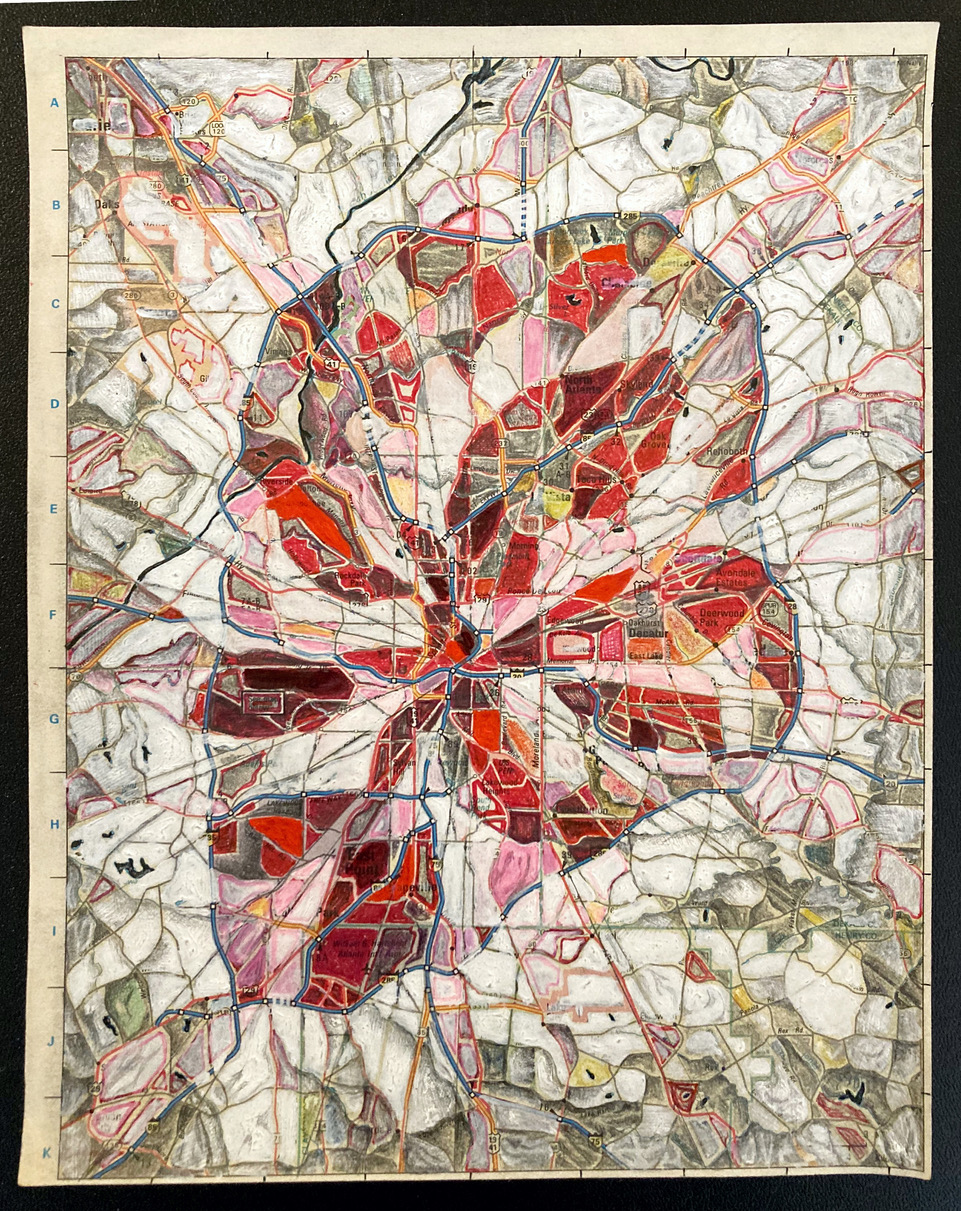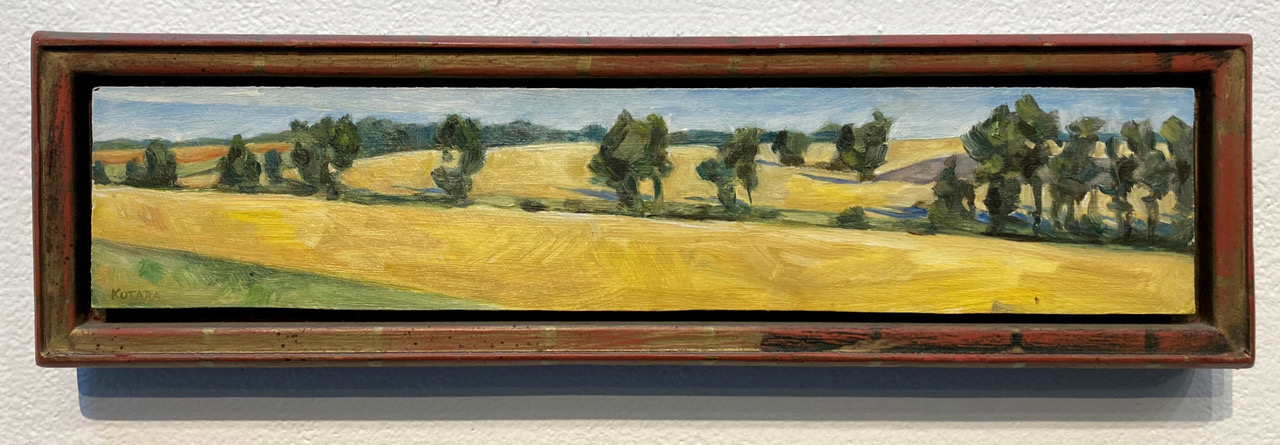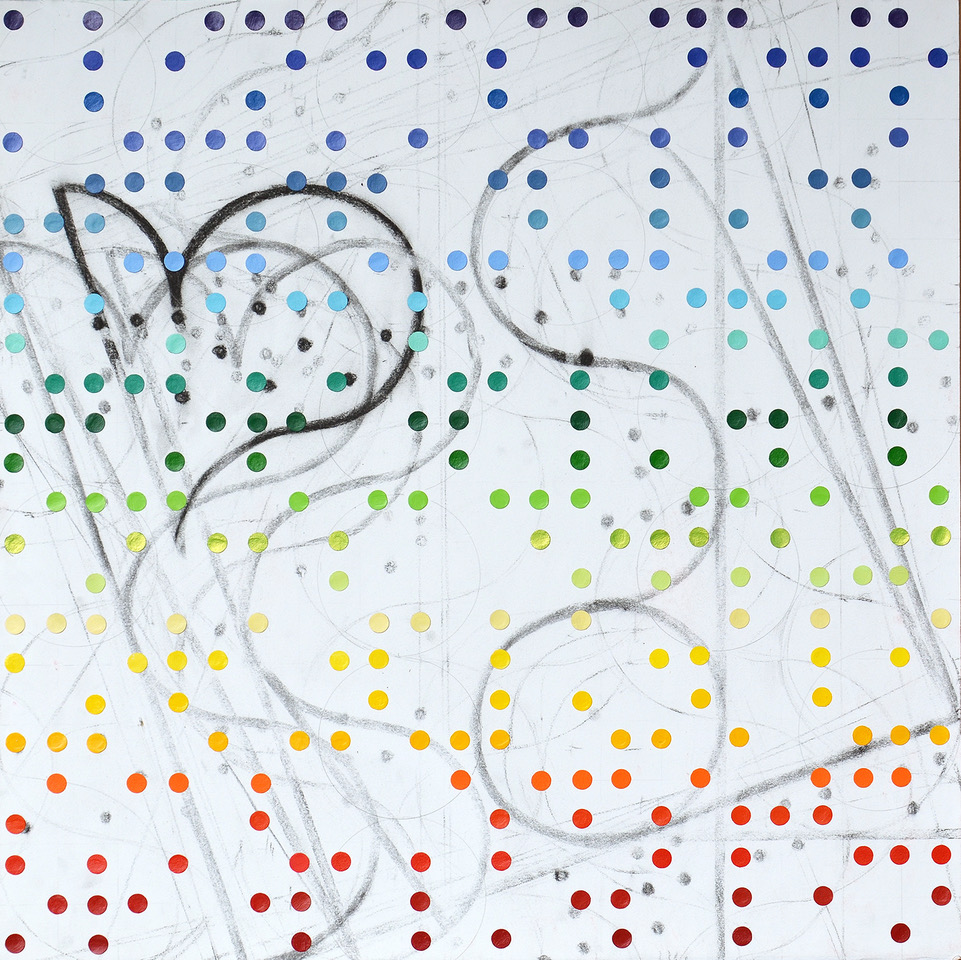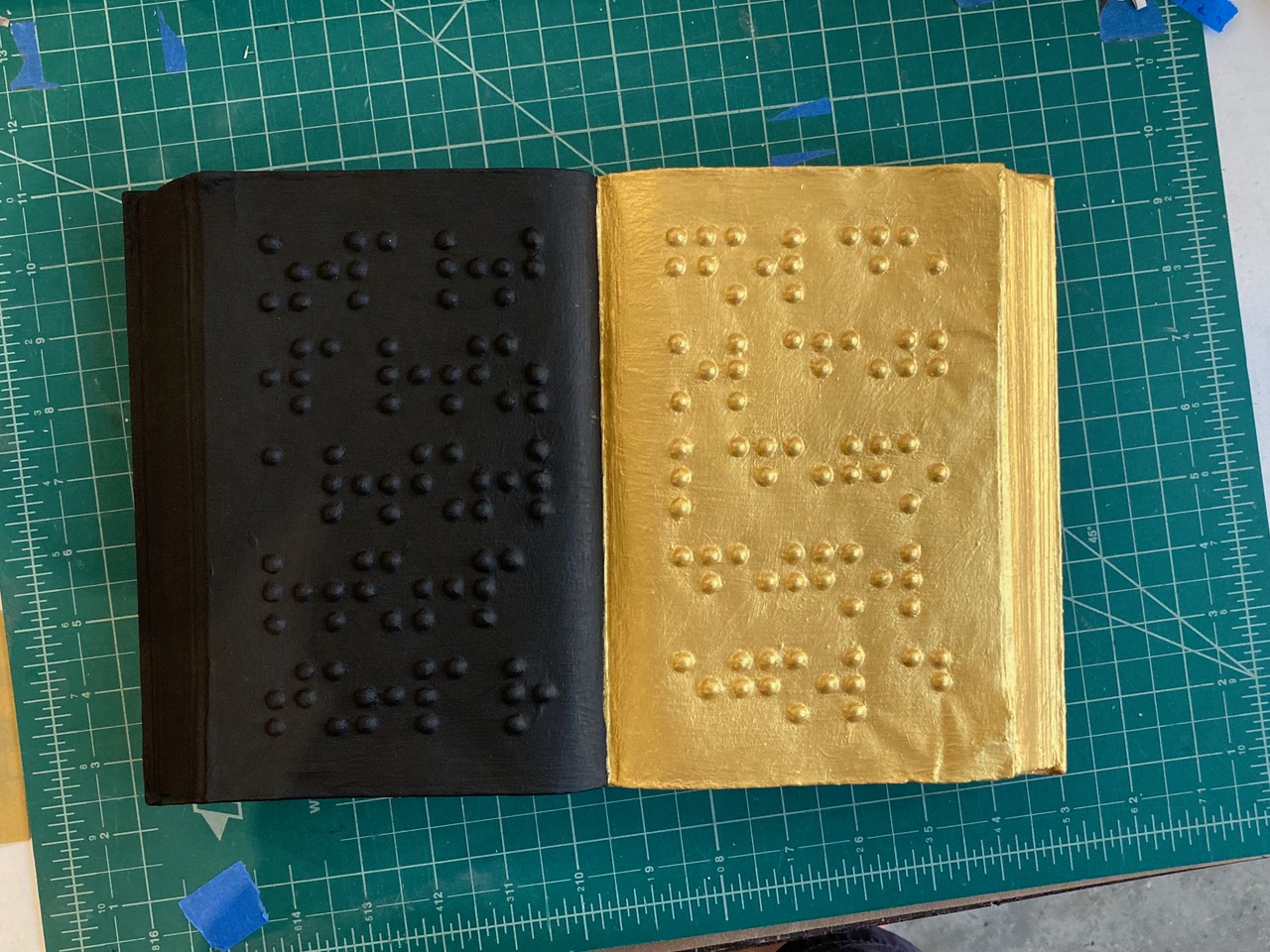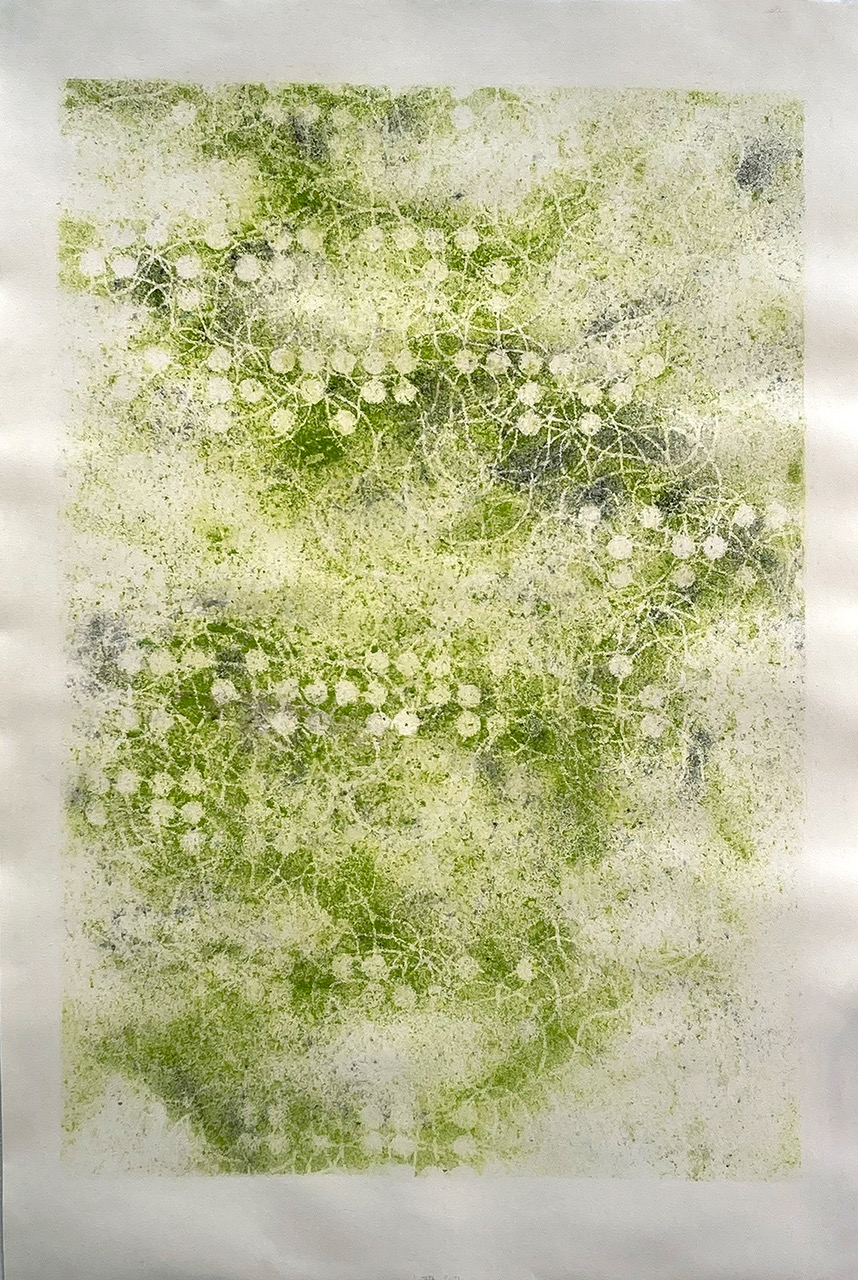Artists question everything. It is a philosophical quest to discover new vantage points. It can be a maddening process leading to more questions than conclusions. From the outside perspective, standing in front of a finished piece, often it is assumed that the artist has created the painting for the pure joy of it, effortlessly applying both paint and creative magic. But as we explore in this conversation, an artist that has chosen it as a life path must show up every day – whatever it may bring – and dedicate themselves not only to the pursuit of excellence in their medium, but with a commitment to uncovering their authentic selves.
CONVERSATION.16
Throughout the years you’ve had your artistic practice, what experiences have shaped your views and values?
K: Inevitably at some point when I was teaching a class, a student would have this eureka moment and say, “Wow! I love this! This is so much fun!”
I got to the point where I adopted the reply, “No dropping ‘F’ bombs in the class!” Of course, everyone else in the room would perk up wondering who just swore in class. Well, it’s not the ‘F’ bomb you think,” I would say. “It’s “Fun.”
They would question me, “Don’t you think art is fun?” and I would say, “No.” “Well, what do you think art is?” I would explain that it is a serious endeavor. Then they would ask, “Why do you have to be so serious about it?” and I would ask, “What’s the definition of serious? It’s to be carefully attentive to something and its process.”
Years prior when my son was in elementary school I had gone to a school function. While there, I engaged in conversation with a couple – both in the field of medicine. Inevitably, they asked “What do you do?” “I’m an artist,” I said. “Oh, how fun!” they said. It felt almost like a slap in the face. “This is not some sort of entertainment,” I replied. “We go to school for this. We spend long hours just honing our craft, attempting to work with materials, becoming comfortable with techniques, whether it’s painting, drawing, color theory, composition – so much goes into creating a piece of art, that I don’t consider it to be fun. Fun to me is if I wanted to ride a roller coaster or be entertained by a comic.”
It was in this moment that I realized, semantically, words change and alter through their own history. The original definition of the word “fun” is “foolish.” Having conversations with non-art people, they oftentimes consider what I do as foolish. It is incomprehensible to them why I do what I do because it doesn’t seem to serve a practical purpose. There is a lack of arts education within the general public, so it is largely misunderstood.
Perhaps they are not considering what you are engaging with when you create art. You are being introspective, listening deeply into the unknown. When you do it every day like you have been, it becomes a form of meditation which inevitably brings up the full spectrum of life. By doing this present work, there is an accountability.
K: Now you are getting into the aspect of philosophy. With their work, artists present to the world a mirror of themselves – the values that have been attained up to this point based on experiences and gained wisdom.
elastic collision
2021, mixed media on canvas & wood, 64×73
Just like we spoke of in the last blog about the many “P” words related to art, this exploration surfaced many “F” words. Take, “fine art.” If you look at almost any university website, the art department is listed under Fine Art. So that’s the whole umbrella of our profession.
What is the educational purpose, what’s the goal? First, it is to assist young people to learn how to see. Then, it is to teach them how to manipulate the materials. And finally, arts education teaches the student to mirror their own values and philosophy. But it is also to gain a degree to go out into the professional art world to earn money. And that is the hard part of it.
A doctor answers the call to keep people alive. That is a base functioning for a human. An artist’s creations have the ability to elevate and shift how people view their lives and the world. Both professions require a high level of knowledge and practice. Their perspective salaries are indicators of what people value.
K: Right. There’s no way out of comparing profession to profession. But, a physician learns about the body, the organs. There is a lot of information, research, and data they can call upon to learn what they need to know. But in the art world, we’ve been trained since the late 1800s, early 1900s modernity to one up another person to be different. There are no rule books for this. Artists look backwards to create in the present to move forward. What other profession has that?
Everyone else is basing it on fact and research. That’s also the slippery slope of this ambiguous animal that’s also the crux of why people can’t walk through a modern or contemporary art museum and get it. The book, “Art and Physics,” by Leonard Shlain was written after he took his teenage daughter to MOMA. During lunch, after they had spent a half day there, he asked her, “What did you think?” And she said, “The emperor has no clothes. I don’t get it.”
This prompted him to write this book on art and physics, comparing the advancement of art actually preceding physics in the scientific research inquiry. Artists were seeing things in their own imagination before the physicists could catch up to it. Now, maybe what has occurred is that physics and science have now surpassed art leaving us less relevant in the visualization of our existence.
As I began contemplating over this, I wondered, “What is the point of art, of moving forward with this in the 21st century?” I think we also, even though phones with a “P” is still kind of an “F” word, right? People are so connected through their phones. You see so many people walking around looking at their phones, they are not even aware of their surroundings. It’s a very centralized, myopic focus, through this device.
We have talked about extended cognition before, with the spider and its cobweb. It’s almost as if we are existing in an extended network that gives everyone a sense of purpose.
Or, that hit of dopamine that makes you “think” that this is living and connecting.
K: Yes. Oftentimes in this age of information, I think we’re all trying to straddle what is living and what is fictitious. Getting back to the practice of an artist, I think that any artist who is serious in their intent and their practice is probably going through some of these similar thoughts.
I think at some point, we as artists just continue creating because we don’t know anything else. And then you have to think of how many artists are out there producing work. Some artists at a higher level – the Koons, the Hirsts, the Murakamis – who have hire 30 to 60 people in their studios. They are true factories, mega producing. So you have far more supply than there is demand for artwork these days. With millions of artists producing artwork, there are not enough houses or museums to place this work. And, we haven’t even gotten into the quality of the work. That idea is part and parcel of “This is fun.”
I have a question. For art’s sake, regardless of the business aspect, what propels you to make art? This is not easy work.
K: One, I think this is a great question. I don’t think anyone has truly been able to answer this. I think it’s because sometimes in this society, we still think in such binary terms. You are either an artist or you’re a commercial sell-out.
barbe espagnole 66.03
2021, pastel (pochoir) on paper, 40×26
You talked how they would groom you in art school to think that making money by selling your work would was a sort of sacrilege.
K: What is that impetus – where did that all begin? Artists are basically creating something from nothing. Art puts together a narrative. Then, whether it is a square, a rectangle, a flat surface – you are creating an illusion of three-dimensionality on a two-dimensional surface. How rich is that? Just to gain the skillset to model and mold values and color to create a sense of reality. That to me is one of the first steps to becoming an artist. To create that illusion takes a certain vision. It takes time, energy, careful attention and serious dedication to that craft.
When I first studied art, I began to see that vision over the course of hundreds or thousands of years that people have been making art. We don’t know why people created art a thousand years ago. In the Renaissance period, the church commissioned artists to paint Christian events. In many ways, this is what artists do – we’re just visual story tellers. It may be based on fact, fiction or completely imaginary.
For me, I am a story teller. Whether it’s realist or abstract, it expresses every human emotion. I love the idea of this visual world as my own story space. And, I have been fortunate enough that others have agreed, liked my stories as well, and have bought this.
It’s the oldest form of communication. Thousands of years ago people drew stylistic figures and animals on rocks, possibly to explain a rich place to hunt. It is interesting to look at the scope of art, to see its evolution, but also see an essence of humanity that has withstood time.
K: The early Greeks thought that written language held less value than oral communication. So, one has to wonder if the civilizations before that time valued visualization over oral communication. This brings me to another book by Leonard Shlain that I am reading, “The Alphabet Verses the Goddess: the Conflict Between Word and Image.” Shlain what he is positing is that the written word has changed the way we as a society even deal with one another. He thinks that the written word has brought about a patriarchy, where before the written word was more of a matriarchy, where women had equal status. He is proposing that misogyny and biases came about through the written word. I am just at the beginning of this book, but I look forward to reading this. I find Shlain so inspiring.
He was a neurosurgeon. And, just like the question that sparked the book at MOMA, for this book he was on a trip speaking with a guide as they stood in front of an ancient piece of art. In this moment Shlain could see that when the written word came about, it altered the paradigm and dynamics of civilization as we knew it. {cave drawing photo credit: ArtHouse Studio}
A duality seems to have been created. Before the written word, people communicated through relatable symbols (like the representation of human and animals) that everyone could understand. But language is proprietary information. It must be taught in order to be understood.
K: These are all of the things I think about when I work in my studio. I’m on a mission for the greatest level of clarity that I am suppose to know. Everything I experience outside of the studio comes in here with me. Artwork is an outlet of gained knowledge. So, I do take all this seriously. This is the portal. This is the mirror.
sunshine
2021, pencil on paper, 25.5×19.75
K: I have had some parents say that some of my minimalist work, that their child could do that. And, of course, I laugh and say, “Well, now your child could possibly do this because they have seen someone else do it.” But, to obtain this on the child’s own – no. You will have very few kids that can. You might have a few, but it’s like when I see a trick on a bicycle. I could do that. But, I didn’t think about it originally. That’s the key difference.
Maybe the crux of all this is education, and the ability to disseminate good information to the general public of what art can be, and what art isn’t. Or, to be able to decide between what is quality art, and what is someone putting a spin on artwork. There are some really good wordsmiths out there that can take a sub-standard piece of artwork and elevate to the level of “this is great artwork.”
And, sometimes I can see in the art community what is selling, and all of a sudden it all looks the same.
K: I have met with a number of young people who want to make a living with art, and they are willing to do anything. I will them them, “I appreciate your entrepreneurial spirit in this, but how does that make you feel at the end of the day? Maybe for a while you’re okay with that – you’re selling something. But if you have no purpose or authenticity within that practice, then what are you doing? Are you just putting pretty pictures on the wall?”
It’s like fashion.
K: Yes. Does it work with the couch, right? Sometimes the desire for instant gratification takes over. I don’t feel that it is that simple.
A videographer friend once told me that there are only 12 types of films that you can actually make. So when I consider the categories of art, all of the “isms,” I wonder if we have discovered them all. We went from realism to impressionism, cubism, abstract expressionism, minimalism. Once we got to minimalism with the blank white canvas (which by the way wasn’t the first blank canvas – that happened 60 or 70 years prior) have we not reached the end spectrum? Did we not begin with simplistic cave drawings, and now we have ended up with minimalistic drawings again, so have we not reached a stopping point?
K: Now, all we are doing is mining small, interstitial spaces in between everything that preceded us. It is interesting to ponder. Back in the 70s first announced that painting is dead. I’ve heard this many times since then.
I think we have to stop, take a pause and qualify what we do, because it is questioning value. It is time-related, and it does become a philosophy. You have to think about what you are thinking, and not just do it. I know people who get into a series, and they just keep cranking them out. I understand the value of a series, but at what point does a series just become dull, background noise? I have done series, and asked how many more ways can I do this, and what am I doing it for? Sometimes I realize that it is not for myself anymore. I think I try to meet the demands for someone who wants to put them in a corporation or a home.
Do I have fun in the studio sometimes? Some days are really good in a year. There are very few. But there are those days where you can’t put down a wrong mark. You can’t choose a wrong color. But I still don’t consider that “fun.” It seems like a heightened sense of energy and the dynamics that are in work and in play. Sometimes I try to have fun with this, because if I’m in a downward place, I have to figure out how to make this good again. Every day an artist comes into the studio, we have no template. We have to create or invent our template, that becomes our practice. Working in the studio day in and day out, you have to ask, “What are you going to do today?” Sometimes that template doesn’t even work, so I’ll just decide to clean the studio for a bit. Then, a painting will catch my eye, and I will see something it needs, and then I’m creating again. So it’s kind of trickery sometimes. Tricking yourself into doing the same thing that I’ve been doing now for 30 or 40 years.
The questions still keep coming, right? I’ve seen you paint an entire painting, set it aside, and then go back in and cover the entire thing with a different color. You’re growing as an artist. You can look at something and see that it isn’t working. Do you find instead of getting more answers, you’re getting more questions?
K: That’s a great point. I do have more questions than I do answers. Even putting a mark down at least advances it to a positive place, or advances it to a place where I realize it isn’t going to work at all. It leads me to one or the other.
barbe espagnole 56
2016, mixed media on canvas, 42×56
The word “wayfinding,” and then, “compass” come to mind. You’re being guided whether by your past collective experience, or something else. That’s the mystery of art, right? Why are you doing what you’re doing?
K: But, not only am I looking for the compass, but I also have to be the compass. I have to step back and forth within that, but it comes back to that purpose of story space and realizing this is what I value. Not even the literal values of lights and darks, but it is about the value of my own time, spending weeks, months, or even years on a painting before I consider it to be at a stopping point. Since I have moved into abstraction, I don’t think there’s any finished painting. It just comes to a point where it all works for that moment.
ga.atl
2022, ball point pen, pencil & acrylic on repurposed map print
It’s interesting to me when I hear you talk about you and the work. Sometimes you are the compass and you change the work, but sometimes the work changes you.
K: Exactly. There is a reciprocity. It is a relationship. Once you lay something down, whether it is a mark or a wash, suddenly you have given that piece a voice. It emanates back. It’s as if I am moving through this veil of vagueness, into clarity. Beginning a new piece of art is no big deal to me. It’s easy. It’s completing it that’s the hard part. The studio template is there, but it is wrought with doubts and holes and mis-fires.
If you are mimetic, like a plein air painter, your goal resides with what you are focussing on. You have a constrained set of elements. It is the same for a realist painter that works from a photograph. Their goal is already laid out for them. Mine is process oriented, so the goal is unknown until I reach that endpoint.
yellow fields
1995, oil on panel w/artists frame, 5×18
cell 005
2022, collage, charcoal on paper, 24×24
K: The crux of abstract work is that it is very interpretive. Every person that views this, brings their own perspective. Once you put the work out to the general public, it is no longer your own. It becomes part of that public domain, that public conversation. Often, that language shapes that particular piece into what it can become. That’s the part I find very fascinating. Now, what I think we are missing is that language for society to even have a conversation about abstract work. If it isn’t literal, they might see little to no value in that. Abstract work requires time, attention and introspection, to get to a level of questioning what is true.
If you were to question them about abstraction, or even continually question them to find what is truth and fact, none of us – there are very few people – who can get to the crux of what is true and what isn’t, if you want to prove it. Not that we are trying to prove anything through art, and yet, maybe we are. Maybe we are putting out these subjective narratives as our own proof for our very existence.
Something like a Mark Rothko painting that is bans of color. Some people look at this and say, “I just don’t get it.” It requires time. It requires attention to sit with it for a while. Like the Rothko Chapel in Houston, those colors can change as the light shifts throughout the day. It is completely dependent upon sunlight – ambient light through clear stories. There are no lights in the chapel, so the color is constantly shifting. Isn’t that similar to life in general?
iM365.116.to.hstn
@ Rothko chapel & Newman’s “broken obelisk”
iM.zg
2022, acrylic & furniture nails on repurposed book
K: If you set your phone down and fully immerse yourself in that space, you are dealing with all of your senses. As all of that is shifting and if you were to set out to reach a point of conclusion as to what it all means, you need to figure out what each of those sensory experiences are telling you. What evidence are these senses providing for you?
At any given time, who has the ability to look at something and be aware of what questions form for them? If you are only looking for answers, you will miss the wonder that inquiry makes. Take your Braille pieces – who is willing to do the investigative work to decipher the code, and who wants the quick, easy answer and just asks you what it means?
K: I think the point you are making is that “fun” becomes the immediate answer or response. I have even heard other artists looking at someone’s work and say, “How fun!” Upon hearing that, I realize there is no questioning there. Maybe this is what we are lacking today as a society – the ability to ask the proper questions. It may be that we even lack the interest to ask a question. With phones giving quick answers, we are so over-informed we lack the ability to wonder. And, without wonder, what guides us towards new ideas and understanding?
barbe espagnole R66
2021, pastel & charcoal (pochoir) on paper,10.42.25×28

